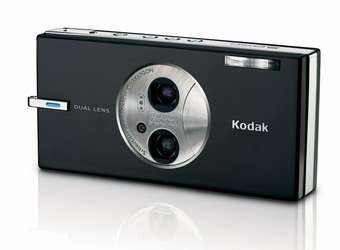Kodak Unveils World’s First Dual-Lens Digital Camera

Ultra-Wide Angle and Zoom Lenses in Compact Body
Kicking off this week’s 2006 International Consumer Electronics Show (CES), Eastman Kodak Company today introduced the world’s first dual-lens digital still camera, the Kodak Easyshare V570 zoom digital camera. Using proprietary Kodak Retina Dual Lens technology, the elegant V570 camera wraps an ultra-wide angle lens (23 mm) and an optical zoom lens (39 – 117 mm) into a small, sleek package less than an inch thin.
The innovative Easyshare V570 camera’s ultra-wide angle lens coupled with its optical zoom lens produces a total 5X optical zoom range, providing more options to help today’s picture takers capture the perfect shot —group photos, scenic landscapes, dramatic portraits, and close-ups. No other consumer digital camera offers such a wide angle of view, nor the unique, sophisticated design of this model, whose all-glass, stacked Schneider-Kreuznach C-Variogon prism lenses never extend from the camera body.
The Kodak Easyshare V570 zoom digital camera with Photo Frame Dock 2 will be available worldwide beginning later this month for US$399 (MSRP).
In addition to its dual lens design, the 5-megapixel V570 camera boasts a variety of notable features to enhance the photography experience, including in-camera panorama stitching, which automatically combines three pictures into a panorama photograph. Using the ultra-wide view in panorama scene mode, people can take in a 180-degree vista with just three shots — an industry exclusive.
Packing advanced video performance, the camera makes it easier for users to shoot all types of action in the way that many filmmakers prefer — with an ultra-wide angle to capture more of the scene. The Easyshare V570 camera records TV-quality video, up to 30 frames per second (fps) using advanced MPEG-4 compression. Built-in image stabilization technology reduces on-screen shaking from unintentional hand and camera movement. The camera also offers an optical zoom feature for video including auto focus. And it is simple to select any frame in a video, then save and print it as a “freeze frame” still picture in just seconds.
Other notable features of the V570 camera include:
-- A big 2.5-inch, high-resolution LCD screen;
-- The exclusive KODAK Color Science image processing chip for phenomenal image quality with rich color, accurate skin tones, low noise and precise exposure;
-- Automatic red-eye reduction, on-camera cropping, picture blur alert and auto picture rotation;
-- In-camera distortion correction to compensate for ultra-wide angle fish-eye effects, which can be turned on or off;
-- Twenty-two scene modes plus three color modes, helping snap shooters capture the best possible shot with the least possible effort;
-- The Photo Frame Dock 2, which provides one-touch picture transfer to a connected computer while keeping the cameras’ high-capacity lithium-ion battery charged and ready to go, and which can play video and photo ‘slideshows’ on the camera’s high-resolution LCD screen;
-- And 32 megabytes (MB) of internal memory, plus a SD card slot for additional storage.
“Today’s picture takers expect high-performance features in an attractive package. Kodak is first to give them a coveted but previously unavailable ultra-wide angle lens in a pocket-size camera,” said Mary Hadley, general manager of digital cameras for Kodak’s Consumer Digital Imaging Group. “Capturing high quality photos with maximum ease of use are at the top of people’s lists when buying a new digital camera. By delivering on these needs in a completely new way, the Easyshare V570 camera pushes the boundaries of innovative design for ultra-compact cameras.”
Source: Kodak
















